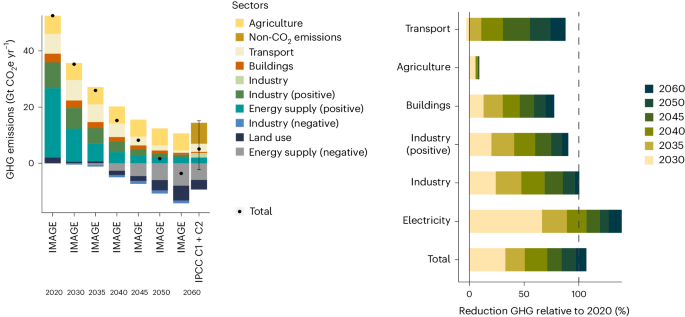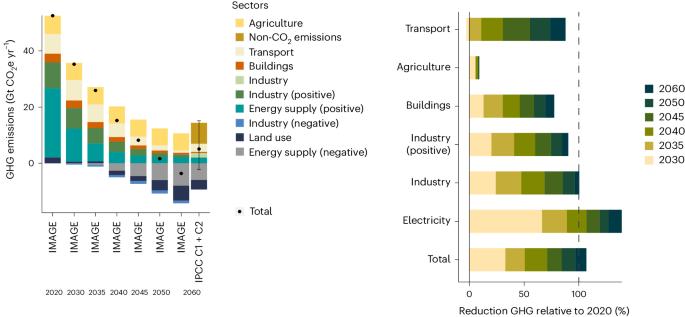Reducing sectoral hard-to-abate emissions to limit reliance on carbon dioxide removal
IF 29.6
1区 地球科学
Q1 ENVIRONMENTAL SCIENCES
引用次数: 0
Abstract
To reach net-zero greenhouse gas targets, carbon dioxide removal (CDR) technologies are required to compensate for residual emissions in the hard-to-abate sectors. However, dependencies on CDR technologies involve environmental, technical and social risks, particularly related to increased land requirements for afforestation and bioenergy crops. Here, using scenarios consistent with the 1.5 °C target, we show that demand and technological interventions can substantially lower emission levels in four hard-to-abate sectors (industry, agriculture, buildings and transport) and reduce reliance on the use of bioenergy with carbon capture and storage. Specifically, demand measures and technology-oriented measures could limit peak annual bioenergy with carbon capture and storage use to 0.5–2.2 GtCO2e per year and 1.9–7.0 GtCO2e per year, respectively, compared with 10.3 GtCO2e per year in the default 1.5 °C scenario. Dietary change plays a critical role in the demand measures given its large share in residual agricultural emissions. Moving towards net-zero emissions requires carbon dioxide removal (CDR) technologies, which bring environmental and socioeconomic risks. This study reveals that demand and technological interventions in hard-to-abate sectors help to achieve net-zero targets with less reliance on CDR.


减少部门难以消减的排放,限制对二氧化碳清除的依赖
为实现温室气体净零排放目标,需要采用二氧化碳清除(CDR)技术来补偿难以消减部门的剩余排放。然而,对 CDR 技术的依赖涉及环境、技术和社会风险,特别是与植树造林和生物能源作物所需土地增加有关的风险。在此,我们使用与 1.5 °C 目标一致的情景,表明需求和技术干预可以大幅降低四个难以消减部门(工业、农业、建筑和交通)的排放水平,并减少对使用碳捕集与封存生物能源的依赖。具体来说,需求措施和以技术为导向的措施可以将每年使用碳捕集与封存生物能源的峰值分别限制在 0.5-2.2 GtCO2e 和 1.9-7.0 GtCO2e,而在默认的 1.5 °C 情景下每年的峰值为 10.3 GtCO2e。膳食变化在需求措施中起着关键作用,因为它在农业残余排放中占很大比重。
本文章由计算机程序翻译,如有差异,请以英文原文为准。
求助全文
约1分钟内获得全文
求助全文
来源期刊

Nature Climate Change
ENVIRONMENTAL SCIENCES-METEOROLOGY & ATMOSPHERIC SCIENCES
CiteScore
40.30
自引率
1.60%
发文量
267
审稿时长
4-8 weeks
期刊介绍:
Nature Climate Change is dedicated to addressing the scientific challenge of understanding Earth's changing climate and its societal implications. As a monthly journal, it publishes significant and cutting-edge research on the nature, causes, and impacts of global climate change, as well as its implications for the economy, policy, and the world at large.
The journal publishes original research spanning the natural and social sciences, synthesizing interdisciplinary research to provide a comprehensive understanding of climate change. It upholds the high standards set by all Nature-branded journals, ensuring top-tier original research through a fair and rigorous review process, broad readership access, high standards of copy editing and production, rapid publication, and independence from academic societies and other vested interests.
Nature Climate Change serves as a platform for discussion among experts, publishing opinion, analysis, and review articles. It also features Research Highlights to highlight important developments in the field and original reporting from renowned science journalists in the form of feature articles.
Topics covered in the journal include adaptation, atmospheric science, ecology, economics, energy, impacts and vulnerability, mitigation, oceanography, policy, sociology, and sustainability, among others.
 求助内容:
求助内容: 应助结果提醒方式:
应助结果提醒方式:


